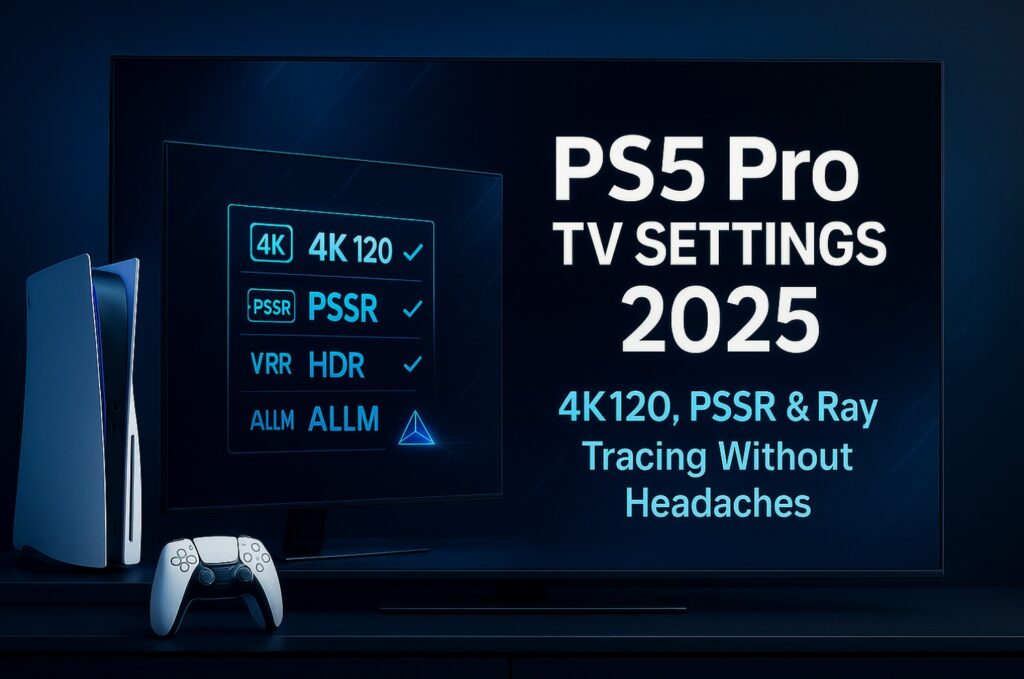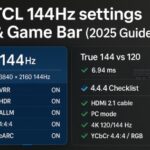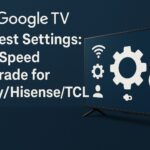If you’ve just unboxed a PS5 Pro and the picture looks “fine but not wow,” you’re not alone. Between 4K120, PSSR, VRR, HDR formats, and game-specific modes, it’s easy to miss the settings that make this console sing. This guide gives you PS5 Pro TV settings 2025 that actually work—clean steps, quick checks, and brand-specific tips that avoid the usual rabbit holes. Think of it as a calm setup session with a friend who’s already tested the pain points, with a small artistic touch: we’ll move from “cold settings” to a picture that feels alive—light, shadow, motion—like stepping from rehearsal into the show. 🌟
Promise: by the end, you’ll have 4K120, stable ray tracing, and PSSR looking crisp—without audio dropouts, random black screens, or muddy text.
Quick Takeaways
- PS5 Pro can push 60–120fps with ray tracing and AI-upscaled 4K (PSSR) in compatible games, provided your TV chain is ready (HDMI 2.1, VRR). PlayStation.Blog
- Use a certified Ultra High Speed HDMI 2.1 cable on the TV’s HDMI 2.1 input (often labeled 4K120/eARC).
- In the console: Enable 120 Hz, VRR, 4K, and ALLM; leave HDR to “On When Supported”; then set per-game graphics modes (Performance/Fidelity “Pro” variants).
- Expect mode juggling: many PS5 Pro titles use PSSR to keep resolution clean while delivering higher frame rates or ray tracing—choose the balance you prefer per game.
- If you see flicker, black screens, or washed blacks, check VRR range, HDMI format, color range (Limited vs Full), and eARC lip-sync (we’ll show you how).
The Signal Chain You Actually Need (and why)
| Component | Minimum for 4K60 HDR | Recommended for 4K120 + VRR + RT |
|---|---|---|
| TV | 4K HDR (HDMI 2.0) | 4K HDR with HDMI 2.1 (120 Hz + VRR) |
| Cable | Premium High Speed | Ultra High Speed (48 Gbps) |
| Console | PS5 Pro (auto) | PS5 Pro (use 120 Hz/VRR/PSSR features) |
| AVR/Soundbar | ARC | eARC (for Atmos + fewer dropouts) |
Why this matters: PSSR can upscale to crisp 4K while the GPU and RT hardware spend their budget on lighting, reflections, or frame rate. Your TV’s port/cable/VRR decide whether those frames actually reach you smoothly.
The PS5 Pro TV Settings 2025 Checklist
You’ll use this list once, then only tweak per game.
- Cable & Port
- Use an Ultra High Speed HDMI 2.1 cable directly from PS5 Pro → TV HDMI 2.1 port (often HDMI 4 on LG/Samsung; consult your model).
- If using an AVR/soundbar, confirm it supports 4K120 pass-through; otherwise run PS5 Pro → TV, then TV (eARC) → Soundbar.
- Console → Screen and Video
- Resolution: Automatic (should show 4K).
- 120 Hz Output: Automatic.
- VRR: Automatic (On when supported).
- ALLM (Auto Low Latency Mode): On (varies by TV; many switch automatically).
- HDR: On When Supported (lets SDR stay accurate, HDR engages in games/apps).
- RGB Range: Automatic (or match Full/Limited to your TV—details below).
- 4K Transfer Rate/Deep Color: Automatic (change only if you see instability).
Reference steps for resolution/120 Hz are in Sony’s support docs.
- In-Game Mode
- Pick Performance Pro (60–120 fps, often with PSSR + some RT) or Fidelity Pro (higher RT quality at lower fps). Titles label these differently—read the info card.
- TV Picture Mode
- Choose Game (or the vendor’s gaming mode) to minimize input lag; disable extra sharpening/noise filters that can blur PSSR output.
- Color & Text Clarity
- For desktop apps/media browsing, ensure 4:4:4 chroma (often automatic in Game/PC label). If text looks frayed, see Sharpness and Color Range tips below.
🥇 If you follow just this section, you’ll already be 90% there.
Brand-Specific Notes (Menu paths can vary by model; check Settings > Picture/Sound/General)
LG webOS (C/G/M series)
- Use Game Optimizer (or Game Mode). Consider Fine Tune Dark Areas if blacks crush.
- Enable VRR toggle if available; OLED Motion (BFI) off for high-Hz gaming.
Samsung Tizen (QN/S series)
- Game Mode: On; Game Bar shows refresh/HDR/VRR at a glance.
- Check Input Signal Plus/HDMI 2.1 format on the chosen port; Contrast Enhancer Off to preserve PSSR detail.
Sony Google TV (XR series)
- Game picture preset; verify VRR in HDMI signal format settings (Enhanced 4K120).
- If you route audio through eARC, set eARC: Auto, Pass-Through: Auto.
Panasonic My Home Screen (LZ/MZ)
- Game Mode for HDMI; set HDMI 2.1 signal format to Enhanced; Intelligent Frame Creation Off for responsiveness.
If your menu names don’t match, don’t worry—vendors rename features across years. Look for Game Mode, Enhanced HDMI, VRR, eARC, Motion controls.
For platform-specific tuning on smart OS behavior (app speed, inputs, clean workflows), our deep dives help:
- Speed Up TCL Google TV 2025 – Fix Lag & Boost Performance (good general Google TV hygiene). TV Compare Pro
- Use Your TV as a Second Monitor 2025 – Complete Setup & Optimization Guide (text clarity, 4:4:4 checklist that also helps consoles in media apps). TV Compare Pro
- TCL 144Hz settings & Game Bar (2025 Guide) (handy even if you’re at 120 Hz now). TV Compare Pro
PS5 Pro + PSSR: What it does (and how to “see” it)
PSSR (PlayStation Spectral Super Resolution) is Sony’s AI-driven upscaling tech on PS5 Pro. Its job is to reconstruct a sharper 4K image from lower internal render resolutions so developers can spend GPU time on frame rate and ray tracing. Many “Pro” modes combine PSSR with improved RT and higher fps—this is why your picture can look clean yet fast.
How to verify PSSR without pixel-peeping:
- Load a game with Performance Pro and Fidelity Pro modes.
- On a paused scene with fine lines (fences, bricks, foliage), toggle modes. With PSSR active, Performance Pro often looks cleaner than you’d expect at that frame rate, while Fidelity Pro may show subtler RT and shading.
- If edges look “shimmer-y,” try turning Sharpness down on the TV; artifacts can be amplified by aggressive edge-enhancement.
- Some early games had PSSR quirks—usually patched quickly—so keep your game up to date. TweakTown
PS5 Pro TV settings 2025 for 4K120 + Ray Tracing (step-by-step)
1) Confirm the pipe
- TV input shows 4K 120 Hz capability; TV info banner/Game Bar should reflect 120 Hz when a game enables it.
- On PS5 Pro: Settings → Screen and Video: Resolution Automatic (4K), 120 Hz: Automatic, VRR: Automatic.
2) Choose your in-game mode
- Try Performance Pro first. This is where PS5 Pro shines: higher frame rates with PSSR keeping edges clean and RT still present (varies per title). TechRadar
3) Set HDR once, keep it stable
- HDR: On When Supported (console).
- TV: keep Dynamic Contrast/Contrast Enhancer Off for accurate tone-mapping; use HGIG if you prefer game-driven mapping (on LG/Samsung models that offer it).
4) Make text and UI look crisp
- If UI looks soft, check HDMI format Enhanced/2.1, use PC/Input Label if available, and reduce Sharpness to near 0–10 (brand-dependent).
- For browsing apps/typing, that 4:4:4 chroma path from our monitor guide helps a lot. See the 4:4:4 checklist. TV Compare Pro
5) Sanity-check audio
- With eARC: set eARC: Auto, Pass-Through (Auto/On), and correct AV Sync. If you notice delay only at 120 Hz, our TCL ARC guide explains the pattern and fixes that also apply broadly.
Troubleshooting (fast triage)
Symptom → Try this
- Black screen when frame rate changes → Ensure HDMI 2.1 “Enhanced/Format” is enabled on that port; turn QMS On if your gear supports it; if not, short blackouts are normal when switching 24/30/60/120. (Apple TV’s Match Frame Rate benefits here.)
- VRR flicker or gamma shifts → Increase the minimum fps cap in game (if offered), disable BFI/OLED Motion, and try TV Local Dimming “Low” in Game Mode.
- Washed blacks/grey HDR → Match RGB Range: set PS5 Pro to Limited if TV is on Limited; use Auto if unsure; in HDR, double-check the in-game HDR calibration screens.
- Ray tracing stutter → Prefer Performance Pro mode; keep VRR On; close background apps; ensure game is updated (many titles patch post-launch).
- Audio delay at 120 Hz → Set TV audio to Passthrough, toggle eARC, and nudge AV Sync by a few ms. If using an AVR at the center of the chain, try PS5 → TV → eARC → AVR/Soundbar. Detailed eARC fixes here. TV Compare Pro
- Text looks fuzzy → Confirm 4:4:4 path, reduce Sharpness, disable Noise Reduction/Edge Enhancement, and—if your TV offers it—PC Input Label.
A Simple Buyer’s Framework (for friends asking “Do I need a new TV?”)
- Already own a 120 Hz HDMI 2.1 TV with VRR? You’re good.
- Have a 4K60 HDR TV (no 120/VRR)? You still benefit from PSSR + higher fidelity, but you’ll miss 120 Hz smoothness.
- Buying today? Prioritize HDMI 2.1 (all gaming ports), VRR, low input lag, and a Game Bar/Info overlay (helps verify 4K120/HDR quickly).
For OS-level smoothness on Google TV sets (TCL/Sony), use our speed-up guide after firmware updates:
Pro Tips (small tweaks with big feel) 💡
- Pin a “test scene” in your favorite game (city street at night, foliage canyon). Switch Performance Pro ↔ Fidelity Pro to feel the RT difference rather than hunting pixels.
- HGIG vs TV Tone Mapping: If your TV supports HGIG, try it—games that respect HGIG give you more predictable highlights.
- Game Bar habits: On Samsung, pull up Game Bar to verify Resolution/Hz/HDR/VRR at a glance; on LG, Game Optimizer overlays essentials.
- Keep the cable short & certified: Many “random” 120 Hz dropouts are just flaky cables.
- Firmware rhythm: Update TV and game first, console last—TV fixes often arrive quietly.
Mistakes to Avoid 🚫
- Chasing “Max Everything.” Many titles can’t do 4K120 + max RT simultaneously. Pick a lane: motion or effects. (PSSR helps, not magic.)
- Leaving Sharpness high. It “crisps” edges but fights PSSR and adds halos.
- Forgetting color range. Full vs Limited mismatch = grey blacks or crushed shadows.
- Using TV motion smoothing in Game Mode. It adds lag and odd artifacts at 120 Hz.
- Routing through old AVRs. They bottleneck bandwidth; use eARC instead.
Extra Value: A 10-Minute Quality Check 🎯
- Motion: Pan the camera in a bright area—should look smooth at 120 Hz with VRR “On.”
- Edges: Check fine lines (wires, signage). They should look clean without halos.
- Highlights: HDR lights (neon, sun) should sparkle without clipping.
- Shadows: Look for detail without grey haze; tweak Black/Shadow Detail carefully.
- Audio: Explosions/dialogue should stay in sync at 120 Hz; adjust AV Sync if needed.
FAQ
1) What are the best PS5 Pro TV settings 2025 for most people?
Use Game Mode, HDMI 2.1 input, Ultra High Speed cable; on PS5 Pro set 120 Hz, VRR, HDR On When Supported, and pick Performance Pro in games. Tweak Sharpness low, Contrast Enhancer off.
2) Does PS5 Pro really do 4K120 with ray tracing?
For compatible games, yes—PS5 Pro can combine ray tracing with PSSR upscaled 4K at higher frame rates (often 60–120 fps), depending on the title’s modes.
3) What exactly is PSSR and why should I care?
PSSR = PlayStation Spectral Super Resolution—AI upscaling that helps keep images sharp while the GPU spends cycles on frame rate or RT. It’s a big reason “Performance Pro” can look cleaner than older performance modes.
4) Should I choose Performance Pro or Fidelity Pro?
Try Performance Pro first for smoothness; Fidelity Pro if you value heavier RT/visual effects and can accept a lower frame rate. Different games tune these differently—check the in-game description. TechRadar
5) Why do I get black flickers when switching frame rates?
Your gear may lack QMS or is renegotiating HDMI. Short blackouts are normal when switching 24/30/60/120 without QMS. Ensure Enhanced/2.1 format is enabled on that HDMI port.
6) My HDR looks grey—what did I do wrong?
Likely a color range mismatch (Full vs Limited) or aggressive TV processing. Set RGB Range Auto, keep Dynamic Contrast/Contrast Enhancer Off, and re-run the game’s HDR calibration.
7) Will PS5 Pro help on a 60 Hz TV?
Yes—PSSR can give you cleaner 4K at 60 fps and improved RT in supported titles, but you’ll miss the 120 Hz VRR benefits until you upgrade the TV.
8) Do I need a new HDMI cable?
If you’re seeing dropouts at 120 Hz, get a certified Ultra High Speed HDMI 2.1 cable—shorter is safer.
9) How do I enable 120 Hz again?
PS5 Pro: Settings → Screen and Video → 120 Hz Output → Automatic. Some games also require enabling a 120 Hz option in their own settings.
10) Which games show off PS5 Pro best right now?
Recent lists call out titles like Spider-Man 2, Astro Bot, FF7 Rebirth, Gran Turismo 7, Alan Wake 2, and more with enhanced modes for PS5 Pro.
Final Verdict
The PS5 Pro TV settings 2025 formula is simple: clean signal (HDMI 2.1 + VRR + 120 Hz), console on Auto where possible, then choose your in-game lane (Performance Pro vs Fidelity Pro). PSSR is the quiet hero—trading raw resolution math for sharper-than-expected images while your GPU budget turns into motion or light. Get the pipeline right once, and every game afterward feels like flipping on stage lights: the scene you meant to see, finally illuminated. ✨🎮
Helpful follow-ups on TVComparePro:
- Use Your TV as a Second Monitor 2025 – Complete Setup & Optimization Guide (text clarity/4:4:4 tips). TV Compare Pro
- TCL 144Hz settings & Game Bar (2025 Guide): True 144 vs 120 + 4:4:4 Checklist (refresh-rate know-how that applies broadly). TV Compare Pro
- Speed Up TCL Google TV 2025 – Fix Lag & Boost Performance (keep the smart side snappy). TV Compare Pro
- Fix HDMI ARC Audio Delay on TCL TVs 2025 (eARC/ARC issues explained). TV Compare Pro



I was suggested this website via my cousin. I’m now not sure whether or not this
submit is written through him as nobody else recognise such
designated about my trouble. You are amazing! Thank you!